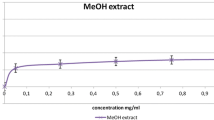Abstract
The effect of administration of PSK (Polysaccharide Kureha), aColiolus preparation, in Meth-A solid tumors was analyzed in BALB/c mice. Spleen cells prepared from normal, non-treated Meth-A bearing, PSK-treated normal and PSK-treated tumor bearing mice were examined for induction of macrophage chemotactic factor (MCF). Only spleen cells from the latter mice produced MCF after 48 hrs of cultivation in the presence of Meth-A cells or Concanavalin A (Con A). MCF-producing cells were indicated to be Lyt-1 positive, L3T4 positive and Lyt-2 negative cells in the negative elimination assay. There were no differences in the production of other cytokines including interleukin-2, inferferon and tumor necrosing factor, spleen cells obtained other different groups of mice. The antitumor effect of either crude or purified MCF (molecular weight 100,000) was examined by daily consecutive intratumoral injections into Meth-A tumor tissues, and a significant inhibitory effect was detected.
Similar content being viewed by others
Abbreviations
- N:
-
normal
- M:
-
Meth-A-bearing
- P:
-
PSK-treated
- PM:
-
PSK-treated Meth-A-bearing
- CS:
-
culture supernatant
- MCF:
-
macrophage chemotactic factor
- Con A:
-
Concanavalin A
- FCS:
-
fetal calf serum
- MW:
-
molecular weight
References
Ebina T, Kohya H, Yamaguchi T, Ishida N. Antimetastatic effect of biological response modifiers in the “double grafted tumor system”. Jpn J Cancer Res 1986; 77: 1034–1042.
Ebina T, Kohya H., Antitumor effector mechanism at a distant site in the double grafted tumor system of PSK, a protein bound polysaccharide preparation. Jpn J Cancer Res 1988; 79: 957–964.
Ebina T, Kohya H, Ishikawa K. Antitumor effect of PSK: Role of regional lymphonodes and enhancement of concomitant and sinecomitant immunity in the mouse. Jpn J Cancer Res 1989; 80: 158–166.
Braley-Mullen H, Tompson JG, Sharp GC, Kyriakos M. Suppression of experimental autoimmune thyroidetis in guinea pigs by pretreatment with thyroglobulin-coupled spleen cells. Cell Immunol 1980; 51: 408–413.
Friedman SM, Hunter SG, Irigoyen OH, Kung PC, Goldstein C, Chess L. Functional analysis of human T cell subsets defined by monoclonal antibodies II Collaborative T-T interactions in the generation of TNF altered self reactive cytotoxic T lymphocytes. J Immunol 1981; 126: 1702–1705.
Suzuki R, Kumagai, K. Induction of IL-3 but not IL-2 or IFN production in the syngeneic lymphocyte reaction. J Immunol 1986; 137: 1564–1572.
Mizushima I. Negative and positive immunological responses in mice pretreated with BCG cell wall. Cancer Res 1984; 44: 20–24.
Honda M, Hayashi H. Characterization of three macrophage chemotactic factors from PPD-induced delayed hypersensitivity reaction sites in guinea pigs, with special reference to a chemotactic lymphokines. Am J Pathol 1982; 108: 171–183.
Miura K, Shimokawa Y, Honda M. Hayashi H. Lyt phenotype of lymphocytes producing murine macrophage chemotactic lymphokine. Cell Immunol 1983; 75: 383–389.
Ishida M, Honda H, Hayashi H.In vitro macrophage chemotatic generation from serum immunoglobulin-G by neutrophil neutral seryl protease. Immunology 1978; 35: 167–176.
Hayashi H, Honda M, Ishida M, Hirashima M. The IgG derived macrophage chemotactic factor in hypersensitivity reaction. In: Kokubu Y and Kobayashi N, eds. Phagocytosis. Tokyo: University of Tokyo Press, 1979: 53–68.
Ward PA, Hill JH. C5 chemotactic fragments produced by an enzyme is lysosomal granules of neutrophils. J Immunol 1970; 104: 535–543.
Kikuta I, Yamamoto T, Kawguchi T, Kambara T. Fifth component of complement (C5) derived high molecular weight macrophage chemotactic factor in normal guinea pig. Inflammation 1987; 11: 459–479.
Cohen S, Ward PA, Yosha T, Burek CL: Biologic activity of extract of delayed hypersensitivity skin reaction sites. Cell Immunol 1976; 9: 363–376.
Cianciolo GJ, Snyderman R. Effect of tumor growth on host defense. Cancer Metastasis Rev 1986; 5: 15–27.
Plaescia OJ, Pontier GM, Brown J, Basis S, Ippoliti F, Bellelli L, Sezzi ML, Lipari M. Amplification by macrophage of prostaglandin mediated immunosuppression in mice bearing syngeneic tumors. Prostaglandins Leukocytes and Medicine 1984; 16: 205–223.
Rita MY, Shimmermaker JA: Prostaglandin E2 regulation of tumoristic factor production by macrophage like P388DI cells. J Natl Cancer 1984; 73: 959–962.
Author information
Authors and Affiliations
Rights and permissions
About this article
Cite this article
Ishikawa, K., Majima, T. & Ebina, T. Antitumor effect of aColiolus preparation, PSK: Induction of macrophage chemotactic factor (MCF) in spleens of tumor bearing mice. Biotherapy 5, 251–258 (1992). https://doi.org/10.1007/BF02179042
Received:
Accepted:
Issue Date:
DOI: https://doi.org/10.1007/BF02179042




